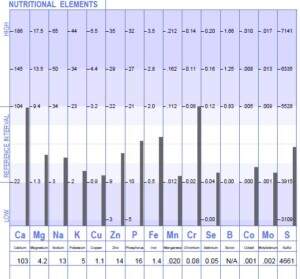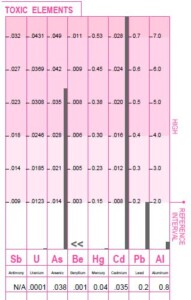Why test the hair?
Identifying, recommending, and analysing appropriate tests is an important part of my work. I regularly recommend blood tests (either through a GP or privately). I also work with many other functional medicine tests including comprehensive stool analysis, as well as food intolerance, hormone, and genetic testing. Test results help inform my therapeutic recommendations and ensure that my advice is truly personalised.
One of my favourite tests is Hair Tissue Mineral Analysis (HTMA), because it is non-invasive, economical, and provides such a wealth of information about multiple aspects of a person’s health.
Who can benefit from hair tissue mineral analysis (HTMA)?
In my view, everyone can benefit from hair tissue mineral analysis. I use it regularly with clients suffering from fatigue, stress, hypothyroidism, allergies, frequent infections, anxiety, osteoporosis, gut issues, PMS, and for women approaching or going through menopause. It is also an excellent test to run for children, as it is non-invasive.
What can hair tissue mineral analysis tell us about our health?
“As the hair is being formed, prior to extrusion from the scalp, it is exposed to the blood lymph and intracellular fluids. During this time, it accumulates constituents present in this internal environment, particularly the mineral, but other substances as well. As the cortex of the hair shaft hardens and protrudes from the scalp, the evidence of this internal metabolic environment is preserved as a convenient record.” (Dr. David L. Watts)
A hair mineral test analyses the 4cm of hair closest to your scalp, providing a record of the mineral activity that took place at a cellular level over the last three to four months (the time that it takes for 4cm of hair to grow).
The HTMA report includes:
Mineral levels

HTMA provides valuable information about whether your mineral levels are optimum, deficient, or excessive. The minerals included are calcium, magnesium, sodium, potassium, phosphorus, copper, zinc, iron, manganese, chromium, selenium, cobalt, molybdenum, sulphur, and others.
Minerals are often referred to as “the spark plugs of life”, as they are catalysts for so many biochemical reactions. Optimum mineral levels are a vital requirement for our wellbeing. If they are too low, many body processes will be compromised. Problems can also result from excess mineral levels: for example, iron, copper, manganese, and selenium can be toxic in excess.
HTMA also provides insights regarding the bioavailability of minerals. For instance, many of my clients have high hair tissue calcium levels. This is often not due to excessive calcium intake but instead results from poor bioavailability caused by a lack of nutritional co-factors, stress, or the presence of toxic metals.
I can also glean information about a client’s digestive function from the HTMA. For example, low mineral levels across the board could point to insufficient stomach acid and inadequate digestive enzymes resulting in malabsorption. This would lead me to enquire how a client feels after eating, whether they suffer from bloating or heaviness, and about their stools, etc.
When analysing a client’s report, I also evaluate the patterns of minerals, because particular patterns may indicate potential health imbalances.
Mineral ratios
The report details the ratios between essential minerals – calcium/phosphorus, sodium/potassium, calcium/potassium, zinc/copper, sodium/magnesium,calcium/magnesium and iron/copper.
The ratios and relationships between the minerals are even more revealing than the individual mineral levels. I find this part of the report particularly exciting because it provides crucial insights into multiple aspects of a client’s health, including adrenal and thyroid function, metabolic type (slow or fast), blood sugar regulation, stress levels, immune response, and oestrogen/progesterone balance.
Toxic metals:
“Toxic metals are minerals that do not have any known biological functions and are considered poisonous to the biological system. They are often referred to as heavy metals due to their high atomic weights and they tend to displace the lighter nutritional metals, such as zinc, calcium, iron, etc.” (Dr. David L. Watts)

Toxic metals such as lead, aluminium, mercury, cadmium, and arsenic, are such a ubiquitous part of our environment that none of us can really escape them. Fortunately, our bodies are equipped with processes to help eliminate toxic metals as long as we have the nutrients available to support this process.
The excretion of toxic metals from the body involves a complex chain of reactions, and if any of the phases are not working properly, elimination may be unsuccessful (Textbook of Functional Medicine p. 550). To effectively eliminate toxic metals, adequate levels of minerals are essential. For example, low levels of iron could result in an inability to excrete aluminium. Likewise, selenium and zinc deficiency can interfere with the elimination of mercury, resulting in an increased body burden of this toxic metal.
The accumulation of toxic metals in the body has been linked to many health problems, as they may interfere with vital enzymes and cause damage to lipids, proteins, and DNA via the production of free radicals (Jan, Arif Tasleem et al. 2005). Toxic metals also compete with nutritional minerals, leading to displacement and excessive loss of minerals from the body (Textbook of Functional Medicine, p.550).
HTMA identifies any potentially problematic heavy metals and provides vital information about nutritional mineral imbalances and other underlying causes that may be exacerbating the problem. Once we have identified the issues to be addressed, we can do something about them.
“Human hair has been accepted as an effective tissue for the biological monitoring of toxic heavy metals by the U.S Environmental Protection Agency and is being used for this purpose around the world.” (Dr. David L. Watts, Trace Elements and Other Essential Nutrients)
HTMA as a stress indicator
HTMA provides important insights into how well my clients are coping with stress physiologically and on a subconscious level. Sometimes clients have told me during the initial consultation that their stress levels are low. However, their hair mineral analysis shows either an acute stress reaction or depleted adrenal glands (indicating chronic stress). When I have discussed the results with them, they have often revealed a situation in their lives that they didn’t mention previously because they didn’t realise it was causing them so much stress. I have found with many of my clients that the HTMA test is a catalyst for positive nutritional and lifestyle changes.
The difference between tissue and blood levels of minerals:
Blood tests are extremely important, and I always ask to see blood tests results if they are available. I also regularly refer clients for blood tests. However, when it comes to minerals, blood levels are not always reflective of tissue levels of minerals. This is because the body keeps a very tight check on blood levels of minerals to maintain homeostasis. This balance will be maintained at the expense of other tissues. For instance, if blood calcium drops too low, calcium will be released from the bones to restore blood levels. Blood tests may also be influenced by the time of day that the blood is taken or even by what you have eaten prior to the test.
Hair mineral testing, on the other hand, provides a record of the mineral activity of the tissues over a period of several months, so it can show trends rather than the situation at one moment in time.
Is there any scientific research to support hair tissue mineral analysis?
Yes! I have attached references at the bottom of the page.

Putting it all together
HTMA is an amazing tool, providing a wealth of information for the price. However, as you are more than just your hair, my role is to apply the results to you as a person.
I always use the results of the hair mineral test in conjunction with taking a case history. This includes a discussion about any current symptoms, as well as your medical history, diet, lifestyle, etc. I will then make personalised recommendations, which may include nutritional and lifestyle changes, supplements, tissues salts, and homeopathy.
Taking the hair sample
About 1 teaspoon of hair is required, which needs to be taken from several places from the back of the head. The hair needs to be cut as close to the scalp as possible, and only the 1.5 inches of hair closest to the scalp is used for the test. The test can be run on coloured hair, but it is ideal to wait for 4-8 weeks regrowth.
After booking a test you will be sent a step-by-step guide on how to take the sample.
Fees for HTMA:
New clients:
£175, which includes the hair mineral analysis, a one-hour consultation, and personalised recommendations, which may include nutritional and lifestyle changes, supplements, homeopathy, flower remedies, herbs, and tissue salts.
After booking the test, you will be sent a health questionnaire and food diary form, which I will ask you to complete and email back to me prior to our consultation.
To arrange a test, please send an email to tanya@inspiringhealth.co.uk
Existing clients and retests:
£155 if you have had a consultation with me within the last six months.
Retests are typically recommended 3-4 months after you begin to follow my recommendations.
If you are interested in learning more about natural health, there are lots of articles on my Blog
References relating to the above text:
(1) Jan AT, Azam M, Siddiqui K, Ali A, Choi I, Haq QM. Heavy Metals and Human Health: Mechanistic Insight into Toxicity and Counter Defense System of Antioxidants. Int J Mol Sci. 2015;16(12):29592-29630. https://www.ncbi.nlm.nih.gov/pmc/articles/PMC4691126/
Dr. David L. Watts, 7th Edition 2015, Trace Elements and Other Essential Nutrients,
David S. Jones, 2006, The Textbook of Functional Medicine, The Institute Of Functional Medicine, USA.
References relating to HTMA:
There are hundreds of studies supporting the use of HTMA. I have included few of these below:
Relationship between Hay Fever and Mineral Concentration in the Hair, Lifestyle or Aging
https://www.ncbi.nlm.nih.gov/pubmed/28768942
A comparison of hair and serum trace elements in patients with Alzheimer disease and healthy participants.
https://www.ncbi.nlm.nih.gov/pubmed/26738344
A correlation of breast cancer and calcium levels in hair analyzed by X-ray fluorescence.
https://www.ncbi.nlm.nih.gov/pubmed/25265920
A high accumulation of hair minerals in Mongolian people: 2(nd) report; influence of manganese, iron, lead, cadmium and aluminum to oxidative stress, Parkinsonism and arthritis.
https://www.ncbi.nlm.nih.gov/pubmed/21204778
A pilot study on the metal levels in the hair of hyperactive children.
https://www.ncbi.nlm.nih.gov/pubmed/6645998
An analysis of maternal and fetal hair lead levels.
https://www.ncbi.nlm.nih.gov/pubmed/12452469
Analysis of Hair Trace Elements in Children with Autism Spectrum Disorders and Communication Disorders.
https://www.ncbi.nlm.nih.gov/pubmed/27785740
Analysis of trace elements in the hair of volunteers suffering from naso-pharyngeal cancer.
https://www.ncbi.nlm.nih.gov/pubmed/9258465
Are concentrations of alkaline earth elements in maternal hair associated with risk of neural tube defects?
https://www.ncbi.nlm.nih.gov/pubmed/28763666
Are more nickel ions accumulated in the hair of fixed orthodontic patients?
https://www.ncbi.nlm.nih.gov/pubmed/24025874
Arsenic exposure associated with decreased bone mineralization in males.
https://www.ncbi.nlm.nih.gov/pubmed/23885892
Arsenic in hair and nails of individuals exposed to arsenic-rich groundwaters in Kandal province, Cambodia.
https://www.ncbi.nlm.nih.gov/pubmed/18234288
Assessment of Hair Aluminum, Lead, and Mercury in a Sample of Autistic Egyptian Children: Environmental Risk Factors of Heavy Metals in Autism.
https://www.ncbi.nlm.nih.gov/pubmed/26508811
Assessment of the exposure to elements from silver jewelry by hair mineral analysis.
https://www.ncbi.nlm.nih.gov/pubmed/21286697
Association between essential trace and toxic elements in scalp hair samples of smokers rheumatoid arthritis subjects.
https://www.ncbi.nlm.nih.gov/pubmed/22033362
Association between trace element and heavy metal levels in hair and nail with prostate cancer.
https://www.ncbi.nlm.nih.gov/pubmed/23167323
Association of blood and hair mercury with blood pressure and vascular reactivity.
https://www.ncbi.nlm.nih.gov/pubmed/19743756
Associations of calcium and magnesium in serum and hair with bone mineral density in premenopausal women
https://www.ncbi.nlm.nih.gov/pubmed/17848724
Bioelements in hair of children with selected neurological disorders.
https://www.ncbi.nlm.nih.gov/pubmed/28612063
Biomonitoring of arsenic, cadmium, lead, manganese and mercury in urine and hair of children living near mining and industrial areas.
https://www.ncbi.nlm.nih.gov/pubmed/25434277
Biomonitoring of mercury in hair of children living in the Valencian Region (Spain). Exposure and risk assessment.
https://www.ncbi.nlm.nih.gov/pubmed/30445401
Blood pressure of omnivorous and semi-vegetarian postmenopausal women and their relationship with dietary and hair concentrations of essential and toxic metals.
https://www.ncbi.nlm.nih.gov/pubmed/22470037
Calcium, copper, iron, magnesium, silicon and zinc content of hair in Parkinson’s disease.
https://www.ncbi.nlm.nih.gov/pubmed/16325536
Children’s Hair Mercury Concentrations and Seafood Consumption in Five Regions of Japan.
https://www.ncbi.nlm.nih.gov/pubmed/29313075
Chromium and manganese levels in the scalp hair of normals and patients with breast cancer.
https://www.ncbi.nlm.nih.gov/pubmed/15621924
Chronic atrophic gastritis in association with hair mercury level.
https://www.ncbi.nlm.nih.gov/pubmed/25119602
Computational model for vitamin D deficiency using hair mineral analysis
https://www.ncbi.nlm.nih.gov/pubmed/28923545
Concentration of mercury in hair of diseased people in Japan.
https://www.ncbi.nlm.nih.gov/pubmed/7874464
Correlation between arsenic concentration in fish and human scalp hair of people living in arsenic-contaminated and non-contaminated areas of Pakistan.
https://www.ncbi.nlm.nih.gov/pubmed/21537922
Correlation between serum testosterone level and concentrations of copper and zinc in hair tissue.
https://www.ncbi.nlm.nih.gov/pubmed/21671089
Correlation between the iron, magnesium, potassium and zinc content in adolescent girls’ hair and their academic records.
https://www.ncbi.nlm.nih.gov/pubmed/18935793
Correlation of aluminum and manganese concentration in scalp hair samples of patients having neurological disorders.
https://www.ncbi.nlm.nih.gov/pubmed/25618568
Correlation of hair mineral concentrations with insulin resistance in Korean males.
https://www.ncbi.nlm.nih.gov/pubmed/22777676
Correlation of lithium levels between drinking water obtained from different sources and scalp hair samples of adult male subjects.
https://www.ncbi.nlm.nih.gov/pubmed/27757573
Detection of structural and trace metal changes in scalp hair of radiographers.
https://www.ncbi.nlm.nih.gov/pubmed/8376114
Dietary intake and nutritional status in regard to zinc of institutionalized aged.
https://www.ncbi.nlm.nih.gov/pubmed/886160
Dietary intake and serum and hair concentrations of minerals and their relationship with serum lipids and glucose levels in hypertensive and obese patients with insulin resistance.
https://www.ncbi.nlm.nih.gov/pubmed/20195917
Elemental anomalies in hair as indicators of endocrinologic pathologies and deficiencies in calcium and bone metabolism.


